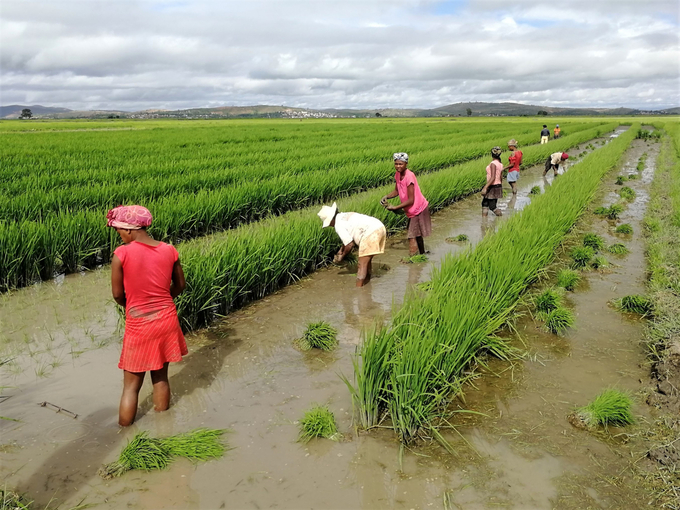November 28, 2025 | 04:43 GMT +7
November 28, 2025 | 04:43 GMT +7
Hotline: 0913.378.918
November 28, 2025 | 04:43 GMT +7
Hotline: 0913.378.918

Growing rice in Madagascar. Photo: FAO/Fanilo Randriatsizafy
The benchmark for world food commodity prices was broadly stable in October, with rising cereal prices more than offset by declines in quotations for other staples, the Food and Agriculture Organization of the United Nations (FAO) reported Friday.
The FAO Food Price Index, which tracks monthly changes in the international prices of a basket of commonly traded food commodities, averaged 135.9 points during the month of October, negligibly below its level in September. With the latest update, the index stood 14.9 percent down from its all-time high recorded in March 2022, while it remained 2.0 percent above its level in October 2021.
The FAO Cereal Price Index increased 3.0 percent during the month. World wheat prices rose by 3.2 percent, mostly reflecting uncertainties related to the Black Sea Grain Initiative and also a downward revision for supplies in the United States of America. International prices of coarse grains increased by 3.5 percent from September, with maize prices rising even more due to lower production prospects in the United States of America and the European Union, along with dry planting conditions in Argentina and uncertainty about exports from Ukraine. International rice prices increased by 1.0 percent.
The FAO Vegetable Oil Price Index declined by 1.6 percent in October and stood nearly 20 percent below its year-earlier level. Rising international quotations for sunflower seed oil were more than offset by lower world prices of palm, soy and rapeseed oils.
The FAO Dairy Price Index dropped by 1.7 percent, with the prices of all dairy products covered down since September. Lower than anticipated purchases by China, lacklustre import demand and the weakening of the Euro against the United States dollar underpinned the drop in October.
The FAO Meat Price Index was down 1.4 percent in October compared to September, with international ovine, pig, bovine and poultry meat prices all declining on broadly subdued global import demand and increasing exportable supplies.
The FAO Sugar Price Index declined 0.6 percent, bolstered by improved production prospects in India. Factors such as rains hampering harvest progress in Brazil, strong import demand from Indonesia and China, and higher ethanol price quotations in Brazil, limited the month-on-month price decline for sugar.
More details are available here. To access benchmark export quotations of various foodstuffs and national retail/wholesale prices of foods please visit FAO’s Food Price Monitoring and Analysis (FPMA) Tool
Lowered forecasts for cereals
In an updated Cereal Supply and Demand Brief also released Friday, FAO lowered its forecast for world cereal production in 2022 to 2 764 million tonnes, a 1.8 percent decline from 2021.
While global wheat production is now forecast at 783.8 million tonnes in 2022, an all-time high, worldwide coarse grains output is expected to drop 2.8 percent to 1 467 million tonnes. World rice production is forecast at 512.6 million tonnes, down 2.4 percent from the 2021 all-time high, but still an overall average crop.
World cereal utilization in 2022/2023 is now forecast to decline to 2 778 million tonnes, 0.7 percent below the 2021/22 level. Likewise, world cereal stocks at the end of seasons in 2023 are forecast to contract by 2.0 percent from their opening levels, down to 841 million tonnes.
Based on those forecasts, the world cereal stocks-to-use ratio is foreseen to decline to 29.4 percent in 2022/23 from 30.9 percent in the previous year.
World trade in cereals in 2022/23 is predicted to register a 2.2-percent contraction to 469 million tonnes.
More details are available here.
For more analysis of recent developments in agricultural markets see the November 2022 issue of Food Outlook, planned to be published on 10 November.
(FAO.org)

(VAN) A new study reveals how the simultaneous effects of ocean acidification, salinity and loss of oxygen are making the world more fragile.

(VAN) Hopes are growing that the creation of the first 3D turkey gut model could be a turning point in the battle against the virulent blackhead disease.

(VAN) Tyson, America’s biggest meat supplier, plans to shutter one of its largest beef processing plants as the industry continues to struggle with low cattle supplies and political pressure from Washington.

(VAN) New FAO study shows how digital solutions are empowering farmers and fishers to prevent losses and build resilient agrifood systems.

(VAN) Brazil's COP30 presidency pushed through a compromise climate deal on Saturday that would boost finance for poor nations coping with global warming but that omitted any mention of the fossil fuels driving it.

(VAN) Poultry farmers in the UK have been warned that they could face one of the worst winters yet for bird flu.

(VAN) Prices of main-crop paddy have risen sharply, with jasmine rice hitting 16,100 baht per tonne — the highest level in years.